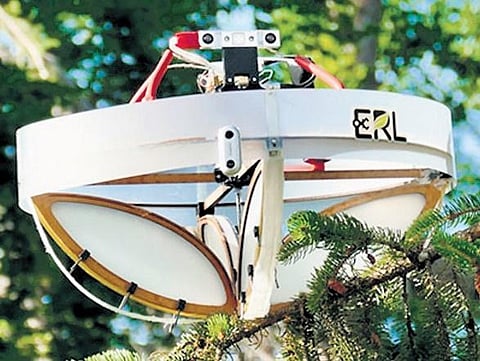

DRONES TO COLLECT ENVIRONMENTAL DNA FOR MONITORING BIODIVERSITY
Ecologists have developed an easier method to detect traces of genetic material left behind by living organisms in the environment, called environmental DNA (eDNA), to catalogue and monitor biodiversity in a particular area. Based on these DNA traces, researchers can determine which species are present in a certain area. Obtaining samples from water or soil is easy, but other habitats – such as the forest canopy – are difficult for researchers to access. As a result, many species remain untracked in poorly explored areas. Now, researchers at ETH Zurich and the Swiss Federal Institute for Forest, Snow and Landscape Research WSL, and the company SPYGEN have partnered to develop a special drone to autonomously collect samples from tree branches in such areas. The drone is equipped with adhesive strips. When it lands on branches the material from the branch sticks to these strips.
PLASTICS, CO2 TO SUSTAINABLE FUEL
Researchers from the University of Cambridge have developed a system that converts two waste streams into two chemical products at the same time – the first time this has been achieved in a solar-powered reactor. The reactor converts CO2 and plastics into different products that are useful in a range of industries. In tests, CO2 was converted into syngas, a key building block for sustainable liquid fuels, and plastic bottles were converted into glycolic acid, which is widely used in cosmetics industry. Converting plastics and greenhouse gases into useful and valuable products using solar energy is an important step in the transition to a more sustainable, circular economy.
BREAKTHROUGH ENABLES TINY E-BIOBOTS TO HELP IN MEDICARE
A path-breaking development in robotics has opened avenues for hybrid biological-cum-microelectronic centimetre-scale robots, called eBiobots, to sense and respond to toxins in the environment, biomarkers for disease, as well as conduct in-situ biopsies and analysis, minimally invasive surgery and even detect cancer. The hybrid ‘e-Biobots’ are first to combine soft materials, living muscle and microelectronics worked out by researchers from University of Illinois, Northwestern University and collaborating institutions. The researchers had earlier pioneered the development of biobots, powered by mouse muscle tissue grown on soft 3D-printed polymer skeleton and had demonstrated walking biobots in 2012 and light-activated biobots in 2016. Although the light activation facilitated a degree of movement control of the biobots, practical applications were limited by the question of how to deliver light pulses to the biobots outside of a lab setting. This was solved by integrating tiny wireless microelectronics and battery-free micro-LEDs to allow researchers to remotely control the e-Biobots. Now, wireless signals can be sent to the e-Biobots that stimulate the light-sensitive engineered mouse muscles to contract, moving the polymer legs so that the machines can actually ‘walk’.
Science is a world in itself. Here are some interesting science that connects with you
Nirad Mudur